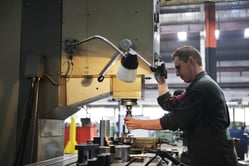
The manufacturing response to the disruption of 2020 was found by one study to be largely reactive and uncoordinated, with many firms’ crisis communication plans not including management of an infectious disease outbreak. Certainly, there are challenges for manufacturing when dealing with such an abrupt, massive disruption, from supply chain disruptions to shortage of business system accessibility, to a lack of worker availability.
But manufacturing trends in 2020 weren’t entirely doom and gloom. The pandemic also served as a catalyst for the manufacturing industry to reinvent itself, adding new technology and software for manufacturing that allowed for shifts like new B2C sales or real-time remote visibility of stock through an ERP.
While some manufacturers faced a lack of capability to deal with increased product demand or a sudden pivot to a new normal, digital technologies also pushed to the forefront. Many businesses thrived in the innovation to meet new manufacturing trends and demands. From those who used 2020 as an opportunity to reevaluate and grow, a recent survey showed several trends emerged. Here are a few of the key insights that were uncovered:
1. Manufacturers and Distributors Must Make Provisions for the Remote Workforce
Unsurprisingly, the survey revealed that 37 percent of companies were unable to provide their employees with the required remote work capabilities. This included back-office positions such as administrative functions as well as front end operations, and indicates that many manufacturers and distributors are still heavily reliant on manual inspections, manual recording, and disconnected processes.
Moving forward, 73 percent of businesses stated they would need to invest in capabilities to facilitate remote working. And while 45 percent of businesses realize that they could lose talent in the future if they do not embrace remote working moving forward, the onus will be on leaders to ensure the improved remote workforce has the necessary skills to utilize the cloud, manufacturing software, and other collaboration tools to the fullest.
2. New Manufacturing Hubs and the Re-Shoring of Supply Chains
As recently as a few months back, most supply chains were heavily integrated and increasingly reliant on foreign raw material. There were a number of benefits to looking offshore, including cost reductions and efficiency. This, of course, often came with the price of quality and control. As soon as global lockdowns resulted in supply chain disruptions, many businesses scrambled to find a new plan.
The survey revealed that 42 percent of businesses have implemented or are planning to implement near-shore or re-shore manufacturing operations. This popular manufacturing trend of reconfiguring supply chains has both an impact on localized requirements as well as dual sourcing policies for supply certainty. Some of the new trending manufacturing hubs include the Philippines, Hungary, Costa Rica, and even Columbia.
3. Rekindled Interest in Industry 4.0
The pandemic has proven that manual and disconnected processes can spell the end of business operations. A report by McKinsey echoed this, stating that the role of Industry 4.0 becomes even more critical on the backdrop of a crisis such as COVID-19. Players utilizing digital solutions and software for manufacturing are better positioned to weather the storm, having moved faster and further than their peers during the crisis.
While manufacturers and distributors have been slow to adopt the cloud due to a number of reasons—some due to the interconnectivity required for operations directly on the shop floor, and others due to the regulatory requirements placed on their industry—things are now changing. In fact, because so many businesses still rely on manual processes, 29 percent of businesses stated they would be pursuing cloud-based business systems moving forward.
Prepare for the Factory of the Future With PositiveVision
The industry is rife with manufacturing trends such as the advancement of the remote workforce, the global appetite for re-shoring, and a renewed interest in cloud technologies. All of this bands together to help push forward the rollout of the factory of the future, shaped by technologies such as business process automation, collaboration portals, messaging gateways, and other software for manufacturing.
Learn more about the Factory of the Future with this free download from Syspro. Need a little help preparing your manufacturing operations and teams for the newest trends and manufacturing software to build the factory of the future? PositiveVision has the experience and the solutions you need to leverage the latest manufacturing trends and build a successful business. Get started with a software expert now.


 © 2019 PositiveVision • 219 E. Thorndale Ave. Roselle, IL 60172
© 2019 PositiveVision • 219 E. Thorndale Ave. Roselle, IL 60172